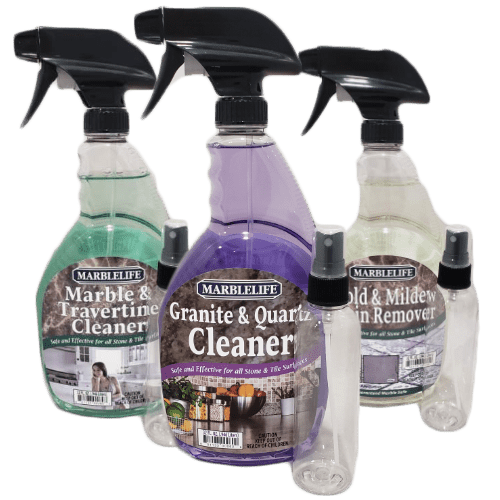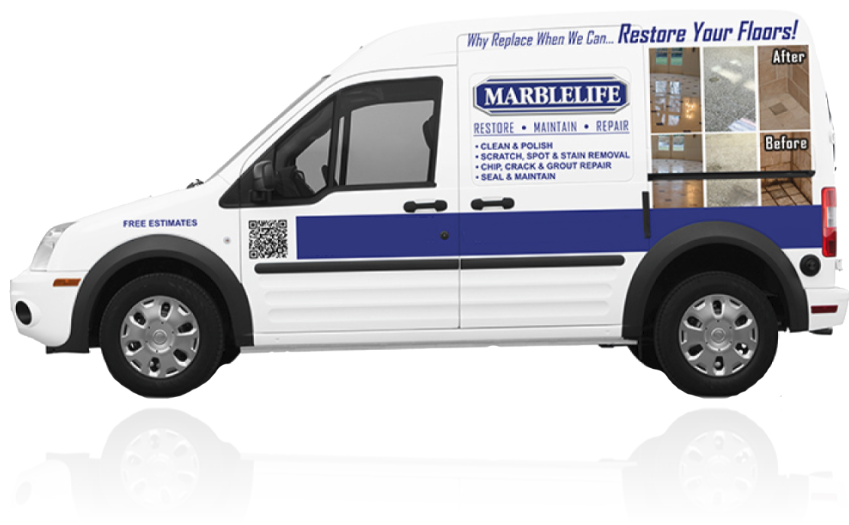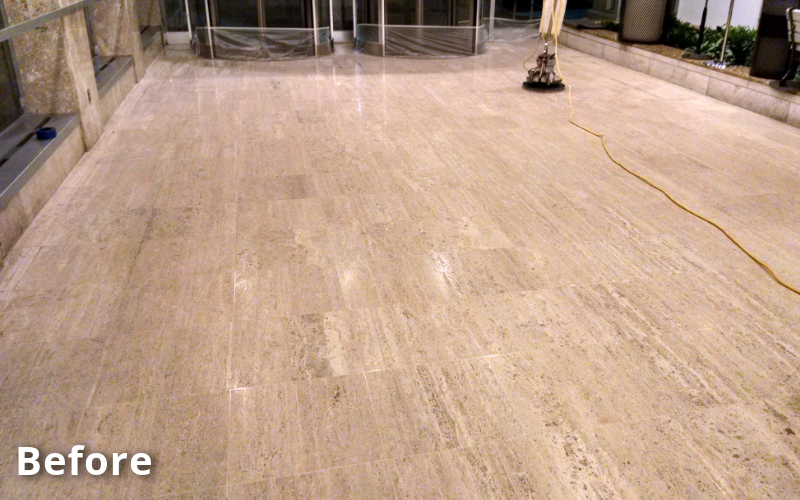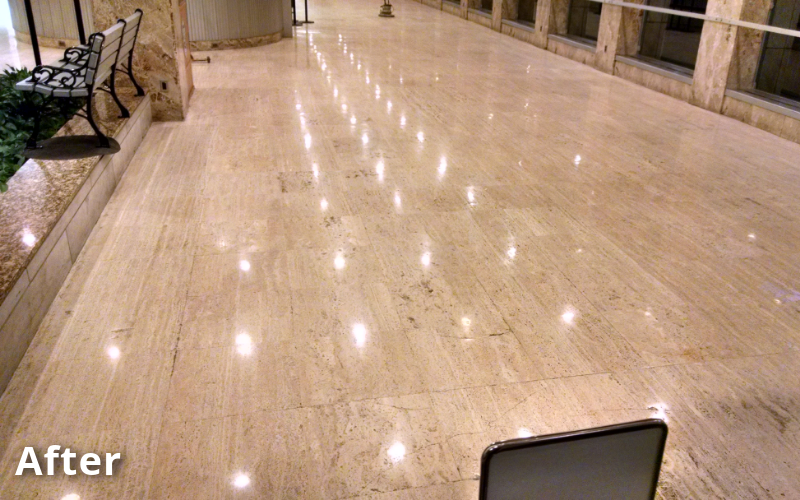Residential Concrete Cleaning Services
Concrete gets dirty. MARBLELIFE Enduracrete can power it back to clean.
If you live in the south, removing mold and mildew stains from concrete is an annual event required by many HOA’s and part of standard commercial building maintenance. MARBLELIFE has long been a leader in builder care assistance. Providing powerwash cleaning services along with customize cleaning solutions designed to help power through that black build-up and maintain an extended clean appearance.
ABOUT CONCRETE CLEANING
MARBLELIFE can work with you to not only restore that clean appearance and building pride, but establish a routine plan to maintain it. If you are one of those hardy souls that gets satisfaction in doing this yourself, consider MARBLELIFE’s Mold-&-Mildew Cleaner as your trustee side-kick. Its professional strength formula is formulated to cut through mold on concrete without harming sensitive stones such as marble and slate nearby. With a strength that is 6-times that found in leading retail offerings the job moves along just about as fast as you can cover the areas with your powerwash equipment. Amazon reports a 61% lower return rate versus competing products, because it works. It works because it has been formulated and optimized to assist your service teams to get the job done right as quickly as possible.
For most building owners, MARBLELIFE can get the job done faster than it would take to research, secure the appropriate equipment and chemicals, and can work with you to make this a routine event. Set-up your pre-existing service and MARBLELIFE will make sure your property is routinely cared for, just another automated system.
Clean concrete can look beautiful. MARBLELIFE can keep it looking its best.
Interested in updating or changing your concrete’s appearance? Talk to your MARBLELIFE Enduracrete representative of the different options available and what might meet your design and location needs. Polished, stained, or anti-slip treatments, concrete adds value, and MARBLELIFE adds value to concrete.
EnduraCrete's Power Washing (Water Recovery) System reduces "Slip & Fall" liability, reduces labor, large areas can be cleaned in less time, with superior results, minimizes facility downtime and increases Health Department ratings.
WHY MARBLELIFE?
- We provide you with the most efficient and trained staff in all the new processes out there, by training our staff in our state-of-the-art R&D Facility in Sanford Florida so that we can bring expert restoration to your doorstep.
- We can handle any situation that you need. Don't believe us? Just check out our trusted clients such as, Rockefeller Center, J. Paul Getty Museum, Ford World Headquarters, Grand Central Station, Marriott, and Ritz Carlton.
- We do the tough work so you don't have to. Oftentimes we see that clients that believe their surface is dirty, when actually it is damaged. Our free assessments can save you hundreds of hours of scrubbing something that may never look clean without professional service.
- We will restore your floors, vanities, showers, and even counters to pristine condition. With more than 1000 restorations a month, MARBLELIFE is the largest residential services provider in the world.
COMMERCIAL CONCRETE CLEANING
MARBLELIFE® restores and maintains more hotels and commercial buildings stone and hard surface floors every month than anyone else in the country. With 30 years’ experience, and more than 50 locations, we deliver world class results with local MARBLELIFE trained and certified stone craftsmen.




Our Value Statement
We sincerely believe that our commitment to excellence in every aspect of our company is the primary basis for our survival in the marketplace. We believe in the worth and potential of every individual. Every person we empower to achieve his or her potential will bring MARBLELIFE® closer to achieving its potential as a leader in our industry.
We understand that our principal product is one of service to our customers, our community, and each other as members of the MARBLELIFE® family. We believe that we are our own best competitors... getting things done, overcoming adversity, growing through vision, and doing the challenging is something we welcome with enthusiasm.
Over the past 30+ years, MARBLELIFE® has become the largest stone restoration and maintenance company in North America, and expanding globally. Our growth is built upon and driven by the referrals and satisfaction of each client we work with.
GET YOUR FREE ESTIMATE TODAY
Use our form below to recieve a customized quote for your project.
Frequently Asked Questions
Why cant I get my concrete clean?
Concrete is naturally porous. Depending on how it is made it can hold 5 to 20% its weight in water. As such, it is effectively a stiff concrete sponge. When something is spilled on your concrete OR it is rinsed with water it can result in staining and discoloration. In the case of a spill, or a drip of oil, the oil/spill enters the concrete pores. You can easily wipe up what is on top of the concrete but what is in its pits and pores is a problem. It is akin to trying to clean the bottom of a test tub with a sponge, you simply cannot reach it to absorb it, or wipe it away. Similarly when one rinses down the surface with water, we are solubilizing the dirt on the surface and transferring it to all the low areas (pores and pits) where it can settle once the water has evaporated. We have moved top-dirt to the bottom of the more difficult to reach pores. As such we recommend BLOTTING spills versus wiping them or hosing them off (unless the floor is sealed or coated). Powerwashing can help clear low level pits by using water pressure to blow out the lose dirt. While better this is unable to restore a uniform-new appearance, and certainly does not address the root cause, the fact that the pits and pores exist and are open to collect dirt.
In order to keep your concrete clean you will want to seal or coat it. Sealing seeks to fill in the pores and pits so that dirt remains on the top surface where it can be swept away, rinsed away or more easily blotted. It is important to note, however that while sealing buys you time to clean up a spill, if the spill is allowed to dwell it will eventually work its way through the seal (clean up those oil slicks, and address the drip under the car, or install a drip pan). A coating provides a more consistent barrier even than sealing but will change the appearance of the floor – in most cases this is a benefit and can be quite artistic. (Check out our ENDURACRETE ENDURACHIP Garage floor coatings or our ENDURACRETE MARBLIZED FLOOR COATINGS where we can transform a raw dull concrete floor to an artistic accent while improving cleanabilty).
In order to keep your concrete clean you will want to seal or coat it. Sealing seeks to fill in the pores and pits so that dirt remains on the top surface where it can be swept away, rinsed away or more easily blotted. It is important to note, however that while sealing buys you time to clean up a spill, if the spill is allowed to dwell it will eventually work its way through the seal (clean up those oil slicks, and address the drip under the car, or install a drip pan). A coating provides a more consistent barrier even than sealing but will change the appearance of the floor – in most cases this is a benefit and can be quite artistic. (Check out our ENDURACRETE ENDURACHIP Garage floor coatings or our ENDURACRETE MARBLIZED FLOOR COATINGS where we can transform a raw dull concrete floor to an artistic accent while improving cleanabilty).
What can I do with stained concrete?
Lets first deal with which “stained concrete” we are referring to. There is a positive stain and a negative stain.
Stained Concrete – Can mean a raw concrete floor where we have a dirty or spill area that has created a “stain.” The most commonly observed stain is associated with automotive fluid leaks or the preverbial “oil stain.” That said, an intentional stain can be introduced designed to alter the concrete appearance and generally impart color ranging from brown, to reds or blues. A wide variety of colors exist. This can be married with a polish to create gloss. In this case, this is a positive stain – we intended it.
So with the negative problem stain, one will want to first clean it (MARBLELIFE ENDURACLEAN is what we recommend). This product is formulated to effectively solubilized, emulsify and lift oils from concrete pits and pores. It is so effective that if you were to wash your hands with it you would instantly have oil free dried skin (not recommended). That said, oil stains can be difficult to conquer as oil is surface active. It wants to spead out over as much surface area as possible. If it has soaked into the floor, one may need to use a poultice to draw the oil out or be prepared to clean, wait for it to re-equilibrate across the surface- and repeat removing the oil you can reach. A poultice is simply an absorbent powder such as diatomaceous earth (pool filter material available at any pool supply store – and very inexpensive). This is soaked with an oil emulsifying cleaner such as MARBLELIFE’s ENDURACLEAN to make a paste with the thickness of mud, wet enough that it sticks together, but not so wet that it drips liquid. Lay this over the oil slick extending 2 inches beyond the slick. Cover with plastic, taped down to the surface, and then cut slits into the plastic to allow air to penetrate. You want this to dry top-down. When wet the cleaner will seek to penetrate the drier concrete below. However once dried on top the concrete is now wetter and it will reverse and begin to pull the oil with it into your poultice. Remove in 24 hours. Repeat as necessary. You should see the stain lighten over time. Be patient this may take 1 to 20 applications depending on how long this has been going on and how much material is down there.
Once addressed, have the floor sealed or coated to keep future spills on the surface. If your car is notorious for dripping install a drip pan to protect your concrete.
Concrete stains are NOT recommended on floors with known stain histories, as the stain can alter the absorption of the concrete resulting in uneven acceptance of the stain. Concrete stains, while beautiful, will accentuate the past history of the floor. If the floor had vinyl tiles on it you will see the outline of the tiles. If the floor had an oil spill you will see the outline of the oil spill. This will also occur if one is polishing the surface. To get a clean look, one would need to install a concrete overlayment and then stain or polish or stain-&-polish the overlayment. Unless you are set on the stained-and-polished concrete look, we would recommend considering a ENDURACHIP or MARBLIZED coating instead as it prevents prior bad history from being seen. This is also recommended for floors that have had crack repairs done.
Stained Concrete – Can mean a raw concrete floor where we have a dirty or spill area that has created a “stain.” The most commonly observed stain is associated with automotive fluid leaks or the preverbial “oil stain.” That said, an intentional stain can be introduced designed to alter the concrete appearance and generally impart color ranging from brown, to reds or blues. A wide variety of colors exist. This can be married with a polish to create gloss. In this case, this is a positive stain – we intended it.
So with the negative problem stain, one will want to first clean it (MARBLELIFE ENDURACLEAN is what we recommend). This product is formulated to effectively solubilized, emulsify and lift oils from concrete pits and pores. It is so effective that if you were to wash your hands with it you would instantly have oil free dried skin (not recommended). That said, oil stains can be difficult to conquer as oil is surface active. It wants to spead out over as much surface area as possible. If it has soaked into the floor, one may need to use a poultice to draw the oil out or be prepared to clean, wait for it to re-equilibrate across the surface- and repeat removing the oil you can reach. A poultice is simply an absorbent powder such as diatomaceous earth (pool filter material available at any pool supply store – and very inexpensive). This is soaked with an oil emulsifying cleaner such as MARBLELIFE’s ENDURACLEAN to make a paste with the thickness of mud, wet enough that it sticks together, but not so wet that it drips liquid. Lay this over the oil slick extending 2 inches beyond the slick. Cover with plastic, taped down to the surface, and then cut slits into the plastic to allow air to penetrate. You want this to dry top-down. When wet the cleaner will seek to penetrate the drier concrete below. However once dried on top the concrete is now wetter and it will reverse and begin to pull the oil with it into your poultice. Remove in 24 hours. Repeat as necessary. You should see the stain lighten over time. Be patient this may take 1 to 20 applications depending on how long this has been going on and how much material is down there.
Once addressed, have the floor sealed or coated to keep future spills on the surface. If your car is notorious for dripping install a drip pan to protect your concrete.
Concrete stains are NOT recommended on floors with known stain histories, as the stain can alter the absorption of the concrete resulting in uneven acceptance of the stain. Concrete stains, while beautiful, will accentuate the past history of the floor. If the floor had vinyl tiles on it you will see the outline of the tiles. If the floor had an oil spill you will see the outline of the oil spill. This will also occur if one is polishing the surface. To get a clean look, one would need to install a concrete overlayment and then stain or polish or stain-&-polish the overlayment. Unless you are set on the stained-and-polished concrete look, we would recommend considering a ENDURACHIP or MARBLIZED coating instead as it prevents prior bad history from being seen. This is also recommended for floors that have had crack repairs done.
How do I hide patches and cracks so that I have a uniform appearance?
If you have had concrete cracks repaired, you are aware that the repair remains visible. Concrete polishing and concrete staining will still allow the crack repair to be seen unless one installs an overlayment first.
There are 2 ways to dress up your concrete floor and restore a clean uniform beautifully accented appearance.
COATINGS - The first is to consider a concrete coatings such as MARBLELIFE’s ENDURACRETE ENDURACHIP or MARBILIZED coatings. Both of these features provide you the ability to introduce color and convert your concrete floor into a showroom. These are popular choices for our clients who own classic cars or sports cars as well as those seeking a large open space for social gatherings.
OVERLAYMENT – If you want a POLISHED CONCRETE or STAINED-&-POLISHED appearance, without seeing the cracks, or history of prior spills, or cross hatch as one will need to install a thin overlayment, a micro-topping if you will. This virgin material hides the prior concrete surface history and provides a clean stainable uniform and polishable surface. As such, there is always a way. So if you are set on that stained-and-polished look or have had someone attempt this and how it accentuates the negative history on the floor we have a way to get you where you want to be.
The garage is the largest area other than the basement in many homes. Dressing up the garage can create an alternate entertainment area for the big game, an buffet or the kids. Marry a closet makeover and this becomes a beautiful space.
There are 2 ways to dress up your concrete floor and restore a clean uniform beautifully accented appearance.
COATINGS - The first is to consider a concrete coatings such as MARBLELIFE’s ENDURACRETE ENDURACHIP or MARBILIZED coatings. Both of these features provide you the ability to introduce color and convert your concrete floor into a showroom. These are popular choices for our clients who own classic cars or sports cars as well as those seeking a large open space for social gatherings.
OVERLAYMENT – If you want a POLISHED CONCRETE or STAINED-&-POLISHED appearance, without seeing the cracks, or history of prior spills, or cross hatch as one will need to install a thin overlayment, a micro-topping if you will. This virgin material hides the prior concrete surface history and provides a clean stainable uniform and polishable surface. As such, there is always a way. So if you are set on that stained-and-polished look or have had someone attempt this and how it accentuates the negative history on the floor we have a way to get you where you want to be.
The garage is the largest area other than the basement in many homes. Dressing up the garage can create an alternate entertainment area for the big game, an buffet or the kids. Marry a closet makeover and this becomes a beautiful space.
How does sealing help me with keeping my concrete clean?
There is nothing worse than reaching the conclusion one should have sealed the floor or a counter AFTER a stain has appeared. Sealing is like insurance, you know you want it after something bad has happened. In this case, you stain your concrete floor or counter.
Concrete is naturally porous. Concrete can hold between 5 and 20% of its weight in water. If water can enter, so can oil or wine. Once inside that porous structure you cannot “wipe” it off or out. Its little different from trying to clean the inside of a test tube with a sponge, you just cant get in there.
Sealing the concrete’s pores keeps any messes on top of the surface where one can easily wipe them up. It buys you time to clean-up before it becomes a permanent stain. Oil is the worst. Nothing worse than to see a big oil stain in the middle of the garage floor. The problem here is there is no way to predict when your car will begin leaking oil. Own it long enough and they all do. As such, by sealing the floor you prepare for the inevitable. When it happens its cleanable. Yes, you can have a clean garage floor and be a grease-monkey – but only if you have sealed the floor – otherwise its just a matter of time.
So what happens if you do stain the floor can it be repaired – in truth – maybe. Sure you can install an overlayment but that is much more expensive than getting the floor sealed originally. Sure, a poultice may work, but what people don’t share is that you may have to re-apply that poultice 20 times with no guarantee of success. That is a lot of work, and it a service company is doing it, that is a lot of service calls. It is significantly more responsible to your pocket book and your home maintenance and value to seal your concrete and your grout, and your natural stone surfaces.
Concrete is naturally porous. Concrete can hold between 5 and 20% of its weight in water. If water can enter, so can oil or wine. Once inside that porous structure you cannot “wipe” it off or out. Its little different from trying to clean the inside of a test tube with a sponge, you just cant get in there.
Sealing the concrete’s pores keeps any messes on top of the surface where one can easily wipe them up. It buys you time to clean-up before it becomes a permanent stain. Oil is the worst. Nothing worse than to see a big oil stain in the middle of the garage floor. The problem here is there is no way to predict when your car will begin leaking oil. Own it long enough and they all do. As such, by sealing the floor you prepare for the inevitable. When it happens its cleanable. Yes, you can have a clean garage floor and be a grease-monkey – but only if you have sealed the floor – otherwise its just a matter of time.
So what happens if you do stain the floor can it be repaired – in truth – maybe. Sure you can install an overlayment but that is much more expensive than getting the floor sealed originally. Sure, a poultice may work, but what people don’t share is that you may have to re-apply that poultice 20 times with no guarantee of success. That is a lot of work, and it a service company is doing it, that is a lot of service calls. It is significantly more responsible to your pocket book and your home maintenance and value to seal your concrete and your grout, and your natural stone surfaces.
I have an oil spot/stain under my car how do I get to out?
If the floor has been sealed, it should just be on the surface and you can pour cat litter on the spill to absorb the bulk. Sweep or shovel this up and into the trash. Now that the bulk of the oil has been removed, clean the surface with a strong degreasing cleaner such as MARBLELIFE ENDURACLEAN formulated specifically to clean up oil and grease. This makes it suitable for the floor but also for cleaning greasy engine parts.
Now if it was not sealed, then we have a more complicated process. After removing what we can from the surface as noted above, we are likely to see an oil spot in the concrete. Oil traps dirt so eventually if we do not address it will look even more pronounced and dirty. To pull the oil out of the pores and pits is going to require a poultice. As the oil may have collected below the surface, and we can only draw out so much at a time, we may be facing the need for several applications.
First, make a degreasing poultice using diatomaceous earth (inexpensive and purchasable at a pool supply store) mix this with a strong degreaser such as MARBLELIFE ENDURACLEAN to form a paste that is moist but not dripping. Pack this over the spill area with a 2 in overlap. Cover with plastic. Cut slits in the plastic to allow the poultice to get air. The plastic is here so that someone does not inadvertently step onto and track poulice material across the floor and into the house. The slits allow the poultice to being to dry. It will dry top down. It starts with the poultice being wet and the concrete relatively dry, so the concrete draws the degreasing cleaner down into the concrete where it will emulsify the oil. Eventually as the poultice dries out, the concrete is now wetter than the poultice and the now oil laden degreaser begins to migrate from the concrete to the now drying poultice. After 24 hours remove the poultice and assess the floor. It should be lighter than before. If not, then our degreaser is not the right solvating compound for what has been spilled here and we will have to select something else, but for oil this is the right material. Repeat by applying a new poultice every 24 hours until we see no positive change in the appearance or the oil stain has been completely removed.
Bare in mind, there are no guarantees that a stain can be removed. If one has experimented with other cleaners it is possible that they have reacted with the oil and altered its solubility resulting in the need for something new OR potentially making it impossible to be removed.
Once removed, save yourself any further aggravation and schedule to have your concrete sealed (followed by your grout, marble and granite surfaces all of which are porous and can stain). Then become an advocate for sealing to save your friends and family the frustration you have just experienced.
Now if it was not sealed, then we have a more complicated process. After removing what we can from the surface as noted above, we are likely to see an oil spot in the concrete. Oil traps dirt so eventually if we do not address it will look even more pronounced and dirty. To pull the oil out of the pores and pits is going to require a poultice. As the oil may have collected below the surface, and we can only draw out so much at a time, we may be facing the need for several applications.
First, make a degreasing poultice using diatomaceous earth (inexpensive and purchasable at a pool supply store) mix this with a strong degreaser such as MARBLELIFE ENDURACLEAN to form a paste that is moist but not dripping. Pack this over the spill area with a 2 in overlap. Cover with plastic. Cut slits in the plastic to allow the poultice to get air. The plastic is here so that someone does not inadvertently step onto and track poulice material across the floor and into the house. The slits allow the poultice to being to dry. It will dry top down. It starts with the poultice being wet and the concrete relatively dry, so the concrete draws the degreasing cleaner down into the concrete where it will emulsify the oil. Eventually as the poultice dries out, the concrete is now wetter than the poultice and the now oil laden degreaser begins to migrate from the concrete to the now drying poultice. After 24 hours remove the poultice and assess the floor. It should be lighter than before. If not, then our degreaser is not the right solvating compound for what has been spilled here and we will have to select something else, but for oil this is the right material. Repeat by applying a new poultice every 24 hours until we see no positive change in the appearance or the oil stain has been completely removed.
Bare in mind, there are no guarantees that a stain can be removed. If one has experimented with other cleaners it is possible that they have reacted with the oil and altered its solubility resulting in the need for something new OR potentially making it impossible to be removed.
Once removed, save yourself any further aggravation and schedule to have your concrete sealed (followed by your grout, marble and granite surfaces all of which are porous and can stain). Then become an advocate for sealing to save your friends and family the frustration you have just experienced.
Why does my floor coating not hold up? Is it MY coating (YES) or ALL coatings (NO)?
If you are asking this question, then you likely have a floor coating that is failing and flaking. This occurs when the coating’s bond strength is insufficient to handle changes in water vapor pressure in the concrete. Concrete contains 5 to 20% open space – air. That air breathes as the concrete heats and cools. If the floor is under a coating and heats up during the course of the day, that air wants to expand but the coating prevents it from doing so resulting in an increase in internal air pressure with the concrete. That is not an issue…until it exceeds the strength of the coating-to-concrete bond. When a coating is sold it generally will disclose its bond strength in psi (pounds per square inch) the same units for air pressure. Air pressure can also increase if the water table in the area increases due to heavy rainfall. As the ground seeks to soak up the water the water vapor pressure in the ground below the concrete increases and with it the water vapor pressure in the concrete. Whether heat or water or a combination, if the air-or-water pressure in the concrete exceed the bond strength of the coating, it will be popped off at the weakest point.
A coating’s ability to survive an increase in air-or-water vapor pressure can be improved if the surface to which it is being adhered is scuffed up or cut prior to application. This increases the amount of surface area on the floor dramatically and as there is an increase in surface being bonded the adhesion strength per inch increases. If we double the surface on the concrete by scuffing the surface we can see a double in the bond strength. One cannot see if the coating applicator properly prepared the floor after the coating has been installed as such it may be difficult to confirm after the fact without a destructive cross sectional view of the concrete (which for obvious reasons is rarely done). A quality installer will include notes indicating their intent to hone the floor as part of their preparation to install the coating, or if cost is a consideration they may offer to reduce their price if you approve this stop being dropped. The difference in longevity can be significant.
Once a coating has failed, it must be removed entirely, otherwise the weakness between the concrete and the coating remains. You cannot repair a poorly bonding coating by coating over it, as the weak bond remains. It needs to be fully removed before the next coating is applied.
The second reason may be due to inadequately cleaning the floor prior to installing the new coating. If the floor has oil contamination or spills these areas can prevent the coating from properly bonding to the floor, resulting in the coating bubbling or flaking in this area in the future. If the floor has not been sealed, cleaning the floor can delay the coating installation as concrete can take sometime to dry. That problem is mitigated by dry-grinding the floor to remove any dirt, oil or former coatings while boosting the available surface area for the coating to bond to, plus adding sites for mechanical bonding.
This is why MARBLELIFE’s standard coating application calls for the floor to be dryground for maximum coating performance and longevity.
A coating’s ability to survive an increase in air-or-water vapor pressure can be improved if the surface to which it is being adhered is scuffed up or cut prior to application. This increases the amount of surface area on the floor dramatically and as there is an increase in surface being bonded the adhesion strength per inch increases. If we double the surface on the concrete by scuffing the surface we can see a double in the bond strength. One cannot see if the coating applicator properly prepared the floor after the coating has been installed as such it may be difficult to confirm after the fact without a destructive cross sectional view of the concrete (which for obvious reasons is rarely done). A quality installer will include notes indicating their intent to hone the floor as part of their preparation to install the coating, or if cost is a consideration they may offer to reduce their price if you approve this stop being dropped. The difference in longevity can be significant.
Once a coating has failed, it must be removed entirely, otherwise the weakness between the concrete and the coating remains. You cannot repair a poorly bonding coating by coating over it, as the weak bond remains. It needs to be fully removed before the next coating is applied.
The second reason may be due to inadequately cleaning the floor prior to installing the new coating. If the floor has oil contamination or spills these areas can prevent the coating from properly bonding to the floor, resulting in the coating bubbling or flaking in this area in the future. If the floor has not been sealed, cleaning the floor can delay the coating installation as concrete can take sometime to dry. That problem is mitigated by dry-grinding the floor to remove any dirt, oil or former coatings while boosting the available surface area for the coating to bond to, plus adding sites for mechanical bonding.
This is why MARBLELIFE’s standard coating application calls for the floor to be dryground for maximum coating performance and longevity.
News About Marble & Natural Stone
WAR-ON-COVID Clean-It-Forwardtm
Help defeat COVID-19 by Cleaning-It-Forward. Instead of using a paper towel to shield contact from a shared surfaces such as gas pumps, ATM touchpads, and Grocery Card handles, how about we spray it down with a quick-acting cleaner and wipe the surface down. Protects us, removes contamination, and protects the next person. Lets remove COVID19 from our lives. Secure a 4 oz refillable bottle for each family member – and lets enter the fight.
Shop Now
MARBLE & TRAVERTINE CARE
Specialty Cleaners and Sealers formulated to provide exceptional results without damaging or etching your marble or travertine surfaces.
Shop NowGRANITE & QUARTZ CARE
Specialty Cleaners and Sealers formulated to allow your granite’s natural beauty to shine without burying it under damaging waxes and oils. Be sure to re-seal every 2 years to avoid potential expensive staining.
Shop NowPIEDRA Y AZULEJOS - CUIDADO DE LA DUCHA
Our showers see moisture, soaps, shampoos, moisturizers, conditioners, hard water and mold spore interactions daily, making it one of the harder surfaces to maintain… unless you have the right products for the job. MARBLELIFE sealers, cleaners and specialty products for shower care.
Shop NowHAVE A BIG JOB?
Have a hotel or commercial property? MARBLELIFE can provide service programs for 1 to 100 properties throughout our network of 50+ locations worldwide.

Whether its one location or a 100 across the USA, we can cover them all



